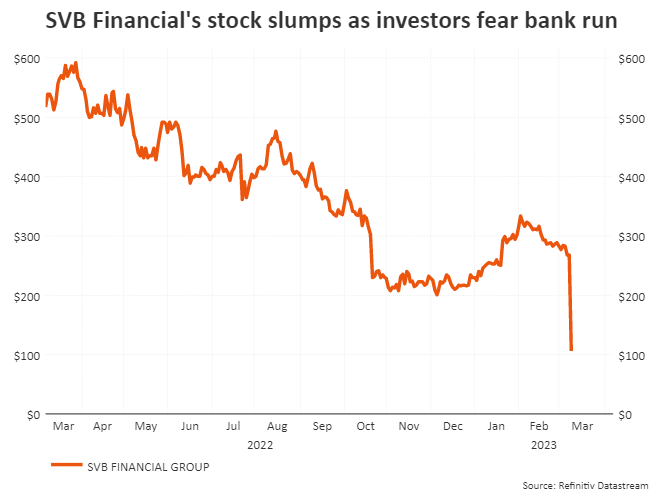The banking industry has been rocked once again, this time by Silicon Valley Bank (SVB), the bank of choice for tech startups. The bank has now been shut down by the FDIC, which has taken control of the bank’s deposits.
On Wednesday, March 8, 2023, the bank made the announcement that it was selling almost all of its securities at a loss that amounted to $1.8 billion as well as billions of dollars in stock.
Of course, SVB CEO Gregory Becker attempted to quell fears. In a call with Venture Capitalists, he asked: “everyone to stay calm and support us just like we supported you during the challenging times.”
He has assured that the bank has “ample liquidity to support our clients with one exception: If everyone is telling each other SVB is in trouble, that would be a challenge.”
However, it seemed that the ship had already sailed, the market responding in panic at Wednesday’s announcement. The stock price tanked 60% and a further 20% in after-hours trading.
Urgent phone calls and social media status updates had echoes of 2008 chaos as already cash-starved startups scrambled to recover their deposits.

Cash burn and the VC desert
Becker’s call for support was not unfounded. SVB has been a major player in the start-up scene, at times offering banking services to new businesses when no other bank would.
This has made it the banking partner for nearly half of the venture-backed tech and healthcare companies listed on stock markets in 2022.
Activity in the VC market has, however, steadily declined throughout 2022, and the bank, propped up by the deposits of VC-backed firms, expected further challenges.

“While VC (venture capital) deployment has tracked our expectations, client cash burn has remained elevated and increased further in February (2023), resulting in lower deposits than forecasted,” wrote Becker in a letter to investors.
With news of more rate hikes on the way and expected market pressure and cash burn, the bank made the decision to improve liquidity, planning to re-invest the funds from Wednesday’s sale in shorter-term debt while doubling its term borrowing to $30 billion.
The bank maintains that it is “well capitalized”. The letter continued to state, ““When we see a return to balance between venture investment and cash burn – we will be well positioned to accelerate growth and profitability.”
“A Risk Problem Not A Technology Problem”
For many experts, the actions, although drastic, seem like “classic balance sheet restructuring” due to the rate and deposit environment.
“You have a very concentrated set of customers in one industry, who are all dried down into pauses at the same time, and you have this hold to maturity, securities, that you’re supposed to not have to sell off for ten years,” said Nik Milanovic, Founder of This Week in Fintech, in the Fintech Nexus News show when talking about SVB and Silvergate.
“Now, all of a sudden, you have to market a market in order to sell them off to shore up your deposit base. And that just creates this spiral.”
“I’m just amazed that neither of these banks, you know, really planned for this rising rate environment or plan for a deposit drawdown with a super concentrated customer portfolio.”
Start-ups that have already faced challenges within the rising rate environment make up the majority of SVB’s deposit base, many storing most of their cash reserves with the bank.
“What’s important to understand is that banks all have leverage. They use deposits, so almost by definition, any bank with a business model is dead if everyone moves,” said Arju Sethi, Co-Founder of Tribe Capital, in a letter to founders and Limited Partners. “Since risk is nonzero and the cost, it’s better to diversify your risk, if not all.”
Founders have been urged by investors to move this cash to avoid exposure to the bank’s liquidity run. Reports of delays, pending transfers, and lack of access to customer service have fanned the flames of fear even further, compounding the bank run.
The attention now turns to the wider banking sphere, as leaders note that many banks may follow the same profile.
“It’s a very boring and generic banking problem that both of these banks are dealing with. It’s just an asset-liability maturity mismatch,” said Milanovic. “What I’m most curious about is how many other banks fit the profile.”
“Is SVB just the first one that’s actually acting on this and rebalancing their portfolio, and are there other small-cap, mid-cap, and regional banks who are in similar situations? We just haven’t heard about it yet.”
In talks for sale
CNBC reported on Friday morning that SVB had hired advisors to explore a potential sale of the bank following a failed attempt to raise capital.
Large financial institutions are said to be considering the purchase. However, the continued rate of deposit outflows is complicating the realistic assessment of the bank by potential buyers.
“It is a franchise that is somewhat unique in negatives, perhaps in some way, but also in positive, its connection to a high net worth VC community,” said CNBC’s David Faber. “So it is something that a number of banks have looked at in the past.”
“If you could get in there quickly and stem the outflow of deposits, you might actually be able to pick something up of great value.”
Closed until Monday
Shortly after, the FDIC released a statement announcing that the California Department of Financial Protection and Innovation had closed the bank, appointing the FDIC as receiver.
Subsequently, the FDIC created the Deposit Insurance National Bank of Santa Clara (DINB) and immediately transferred all of SVB’s insured deposits. These deposits will now be protected, and access will be granted “no later than Monday morning, March 13, 2023.” At this time, SVB will also re-open for business hours.
The FDIC usually covers deposits of up to $250,000, and has stated it is still unclear how many of SVB’s customers held accounts in excess of this amount.
One source told Fintech Nexus that they, along with many of their contacts, held much more than the insured amount in the bank. For the many start-ups and founders who had their primary banking with SVB, the future is still uncertain.